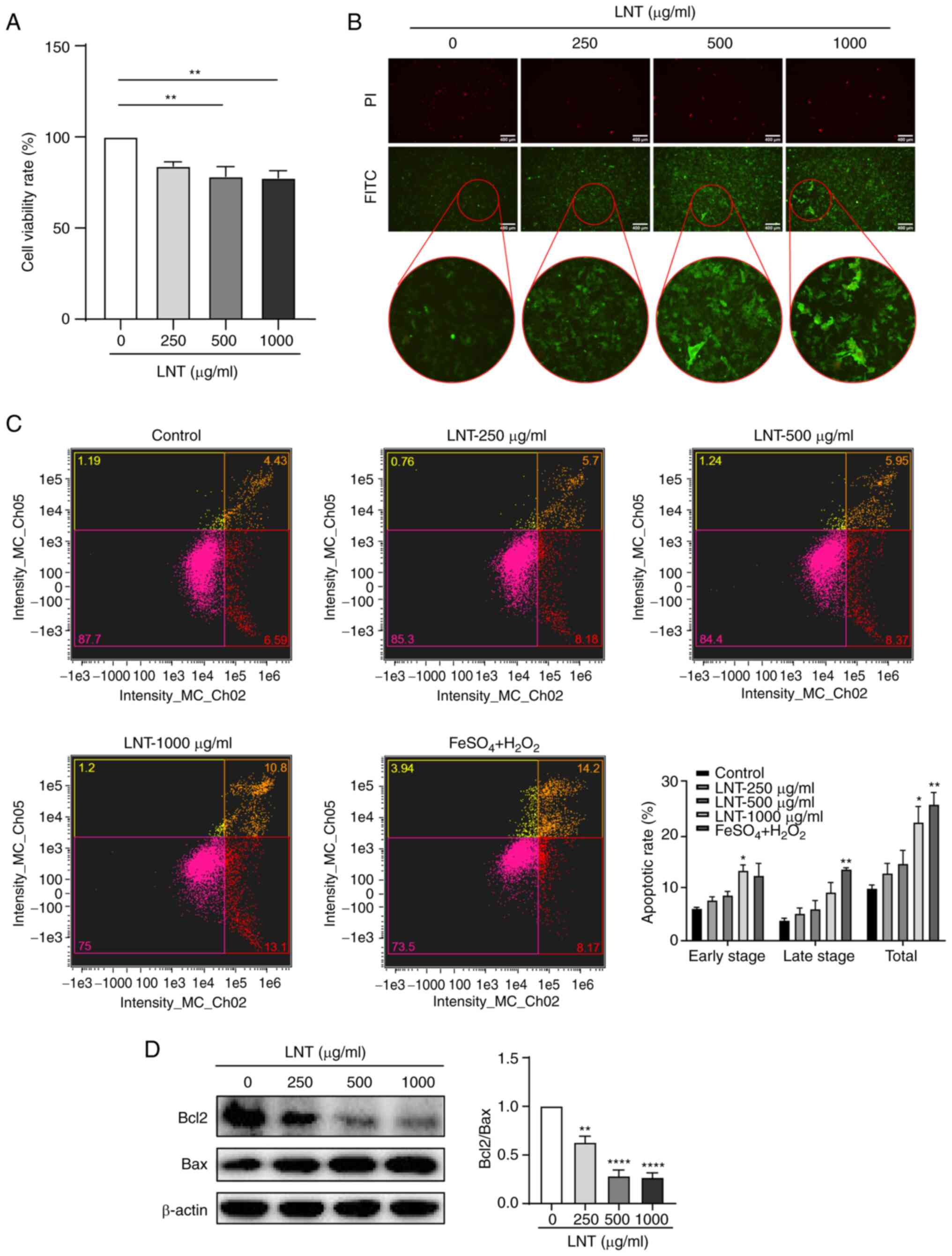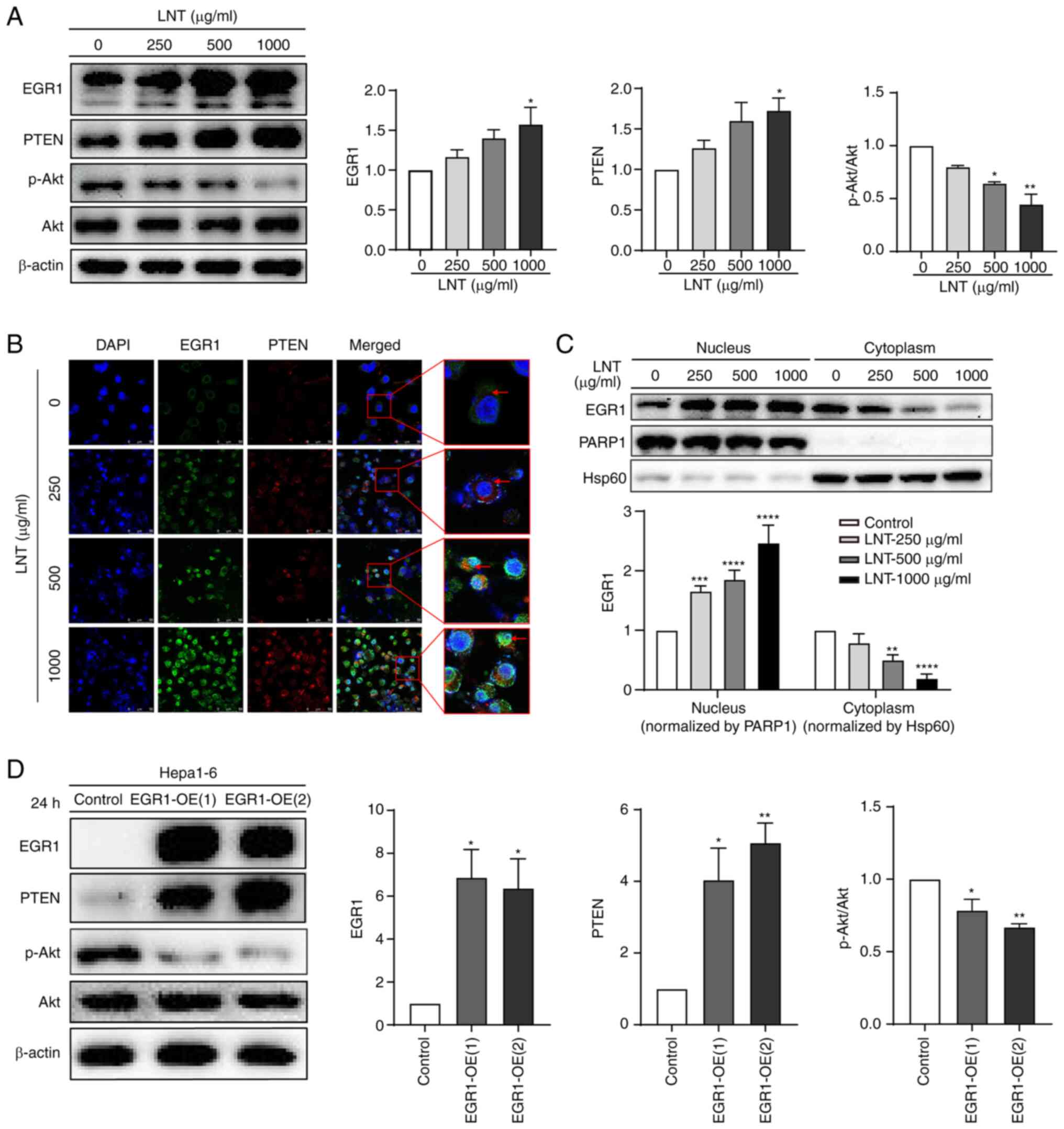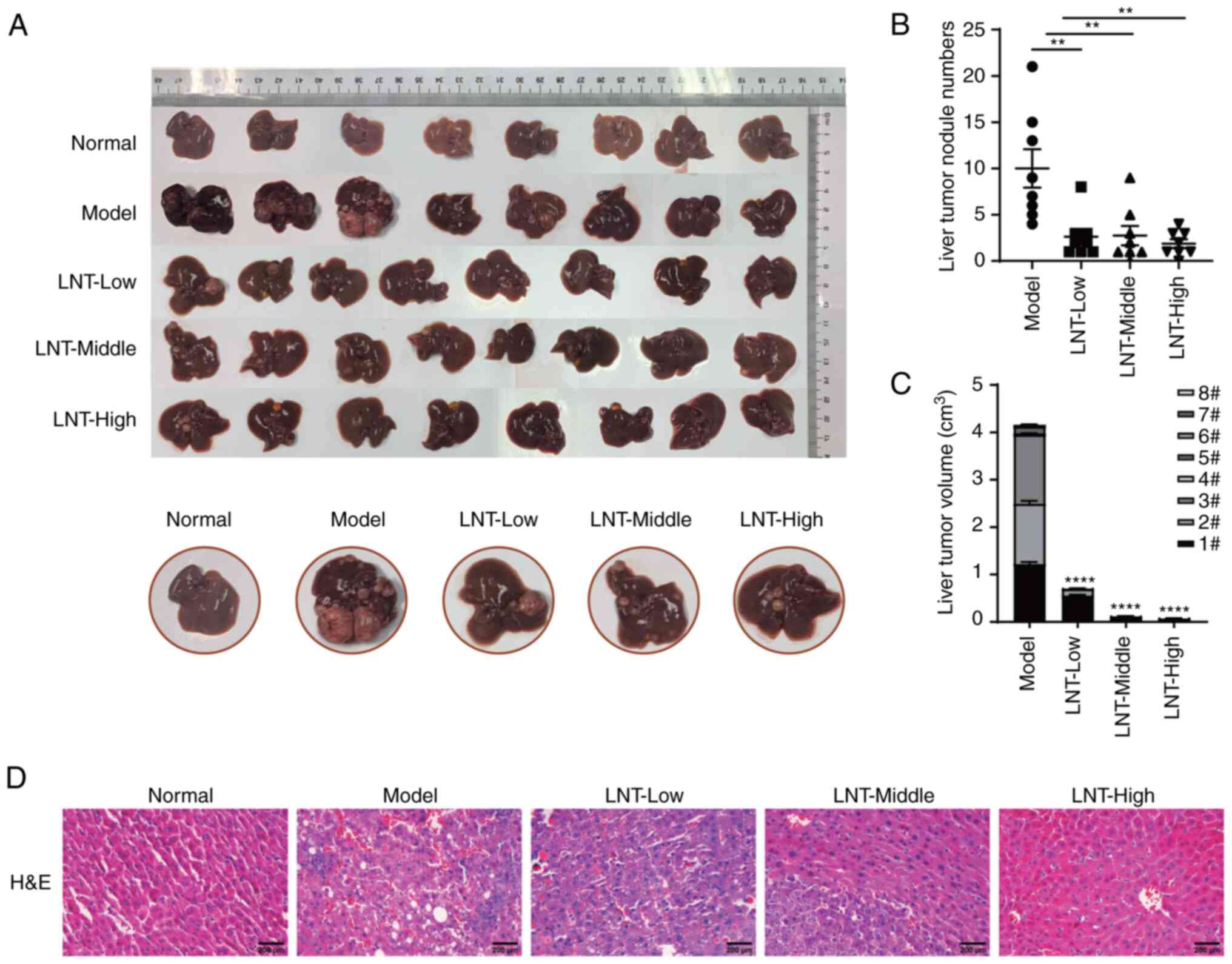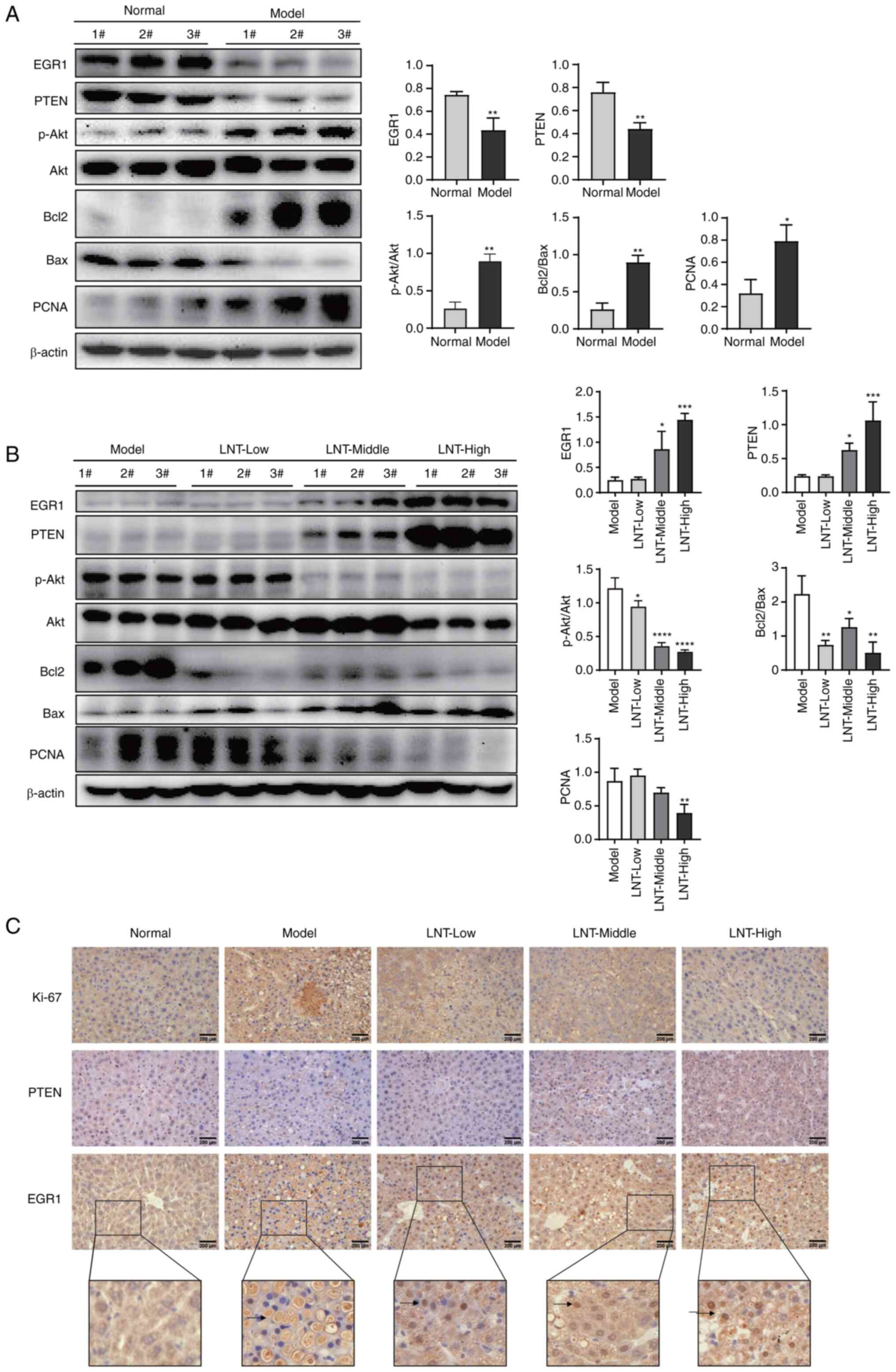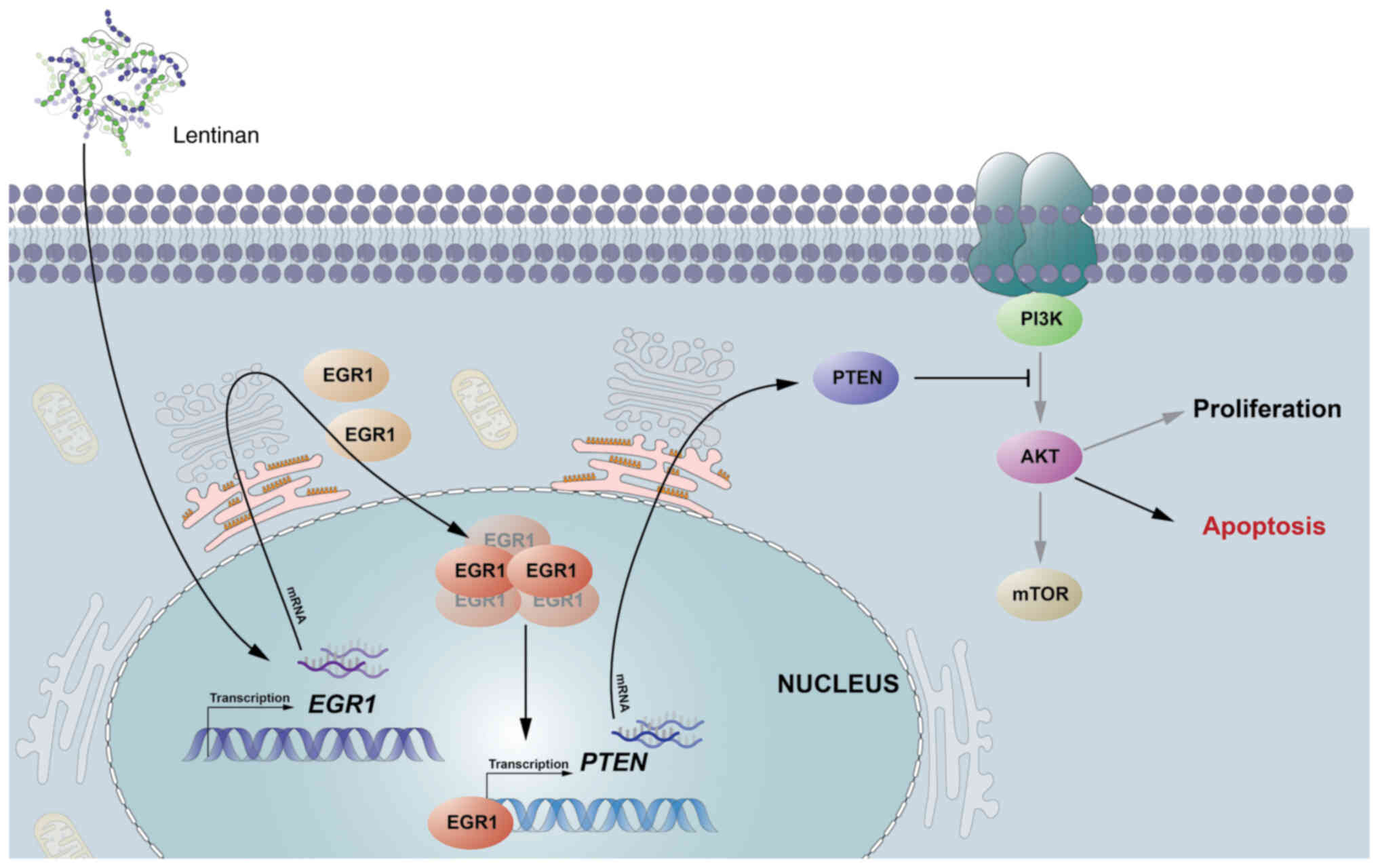|
1
|
Vannucci L, Krizan J, Sima P, Stakheev D,
Caja F, Rajsiglova L, Horak V and Saieh M: Immunostimulatory
properties and antitumor activities of glucans (Review). Int J
Oncol. 43:357–364. 2013. View Article : Google Scholar : PubMed/NCBI
|
|
2
|
Schepetkin IA and Quinn MT: Botanical
polysaccharides: Macrophage immunomodulation and therapeutic
potential. Int Immunopharmacol. 6:317–333. 2006. View Article : Google Scholar : PubMed/NCBI
|
|
3
|
Wasser SP: Medicinal mushrooms as a source
of antitumor and immunomodulating polysaccharides. Appl Microbiol
Biotechnol. 60:258–274. 2002. View Article : Google Scholar : PubMed/NCBI
|
|
4
|
Sheng K, Wang C, Chen B, Kang M and Wang
M, Liu K and Wang M: Recent advances in polysaccharides from
Lentinus edodes (berk.): Isolation, structures and bioactivities.
Food Chem. 358:1298832021. View Article : Google Scholar : PubMed/NCBI
|
|
5
|
Bisen PS, Baghel RK, Sanodiya BS, Thakur
GS and Prasad GB: Lentinus edodes: A macrofungus with
pharmacological activities. Curr Med Chem. 17:2419–2430. 2010.
View Article : Google Scholar : PubMed/NCBI
|
|
6
|
Li S, Huang Y, Wang S, Xu X and Zhang L:
Determination of the triple helical chain conformation of β-glucan
by facile and reliable triple-detector size exclusion
chromatography. J Phys Chem B. 118:668–675. 2014. View Article : Google Scholar : PubMed/NCBI
|
|
7
|
Zhang X, Li T, Liu S, Xu Y, Meng M, Li X,
Lin Z, Wu Q, Xue Y, Pan Y and Alitongbieke G: β-glucan from
Lentinus edodes inhibits breast cancer progression via the
nur77/hif-1alpha axis. Biosci Rep. 40:BSR202010062020. View Article : Google Scholar : PubMed/NCBI
|
|
8
|
Zhang Q, Du Z, Zhang Y, Zheng Z, Li Q and
Wang K: Apoptosis induction activity of polysaccharide from
Lentinus edodes in H22-bearing mice through ROS-mediated
mitochondrial pathway and inhibition of tubulin polymerization.
Food Nutr Res. 64:43642020. View Article : Google Scholar : PubMed/NCBI
|
|
9
|
Sun M, Bu R, Zhang B, Cao Y, Liu C and
Zhao W: Lentinan inhibits tumor progression by immunomodulation in
a mouse model of bladder cancer. Integr Cancer Ther. 19:1–7. 2020.
View Article : Google Scholar : PubMed/NCBI
|
|
10
|
Xu H, Qi Z, Zhao Q, Xue J, Zhu J, He Y,
Liu G and Qin S: Lentinan enhances the antitumor effects of
Delta-like 1 via neutrophils. BMC Cancer. 22:9182022. View Article : Google Scholar : PubMed/NCBI
|
|
11
|
Sung H, Ferlay J, Siegel RL, Laversanne M,
Soerjomataram I, Jemal A and Bray F: Global cancer statistics 2020:
Globocan estimates of incidence and mortality worldwide for 36
cancers in 185 countries. CA Cancer J Clin. 71:209–249. 2021.
View Article : Google Scholar : PubMed/NCBI
|
|
12
|
Lin J, Shi J, Guo H, Yang X, Jiang Y, Long
J, Bai Y, Wang D, Yang X, Wan X, et al: Alterations in DNA damage
repair genes in primary liver cancer. Clin Cancer Res.
25:4701–4711. 2019. View Article : Google Scholar : PubMed/NCBI
|
|
13
|
Gingold JA, Zhu D, Lee DF, Kaseb A and
Chen J: Genomic profiling and metabolic homeostasis in primary
liver cancers. Trends Mol Med. 24:395–411. 2018. View Article : Google Scholar : PubMed/NCBI
|
|
14
|
Song J, Zhou H, Gu D and Xu Y:
Hepatocellular carcinoma differentiation: Research progress in
mechanism and treatment. Front Oncol. 11:7903582021. View Article : Google Scholar : PubMed/NCBI
|
|
15
|
Berger E, Vega N, Vidal H and Geloen A:
Gene network analysis leads to functional validation of pathways
linked to cancer cell growth and survival. Biotechnol J.
7:1395–1404. 2012. View Article : Google Scholar : PubMed/NCBI
|
|
16
|
Liu S, Yao X, Zhang D, Sheng J, Wen X,
Wang Q, Chen G, Li Z, Du Z and Zhang X: Analysis of transcription
factor-related regulatory networks based on bioinformatics analysis
and validation in hepatocellular carcinoma. Biomed Res Int.
2018:14313962018. View Article : Google Scholar : PubMed/NCBI
|
|
17
|
Wang B, Guo H, Yu H, Chen Y, Xu H and Zhao
G: The role of the transcription factor Egr1 in cancer. Front
Oncol. 11:6425472021. View Article : Google Scholar : PubMed/NCBI
|
|
18
|
Yu J, Zhang SS, Saito K, Williams S,
Arimura Y, Ma Y, Ke Y, Baron V, Mercola D, Feng GS, et al: Pten
regulation by AKT-EGR1-ARF-PTEN axis. EMBO J. 28:21–33. 2009.
View Article : Google Scholar : PubMed/NCBI
|
|
19
|
Cui J and Placzek WJ: Post-transcriptional
regulation of anti-apoptotic Bcl2 family members. Int J Mol Sci.
19:3082018. View Article : Google Scholar : PubMed/NCBI
|
|
20
|
Lalier L, Cartron PF, Juin P, Nedelkina S,
Manon S, Bechinger B and Vallette FM: Bax activation and
mitochondrial insertion during apoptosis. Apoptosis. 12:887–896.
2007. View Article : Google Scholar : PubMed/NCBI
|
|
21
|
Liu Y, Huang Y, Ding J, Liu N, Peng S,
Wang J, Wang F and Zhang Y: Targeting akt by SC66 triggers GSK-3β
mediated apoptosis in colon cancer therapy. Cancer Cell Int.
19:1242019. View Article : Google Scholar : PubMed/NCBI
|
|
22
|
Yamaguchi H and Wang HG: The protein
kinase PKB/Akt regulates cell survival and apoptosis by inhibiting
Bax conformational change. Oncogene. 20:7779–7786. 2001. View Article : Google Scholar : PubMed/NCBI
|
|
23
|
Chen TA, Wang JL, Hung SW, Chu CL, Cheng
YC and Liang SM: Recombinant VP1, an Akt inhibitor, suppresses
progression of hepatocellular carcinoma by inducing apoptosis and
modulation of CCl2 production. PLoS One. 6:e233172011. View Article : Google Scholar : PubMed/NCBI
|
|
24
|
Hopkins BD, Hodakoski C, Barrows D, Mense
SM and Parsons RE: PTEN function: The long and the short of it.
Trends Biochem Sci. 39:183–190. 2014. View Article : Google Scholar : PubMed/NCBI
|
|
25
|
Li C and Li X: Circpten suppresses
colorectal cancer progression through regulating PTEN/AKT pathway.
Mol Ther Nucleic Acids. 26:1418–1432. 2021. View Article : Google Scholar : PubMed/NCBI
|
|
26
|
Li R, Xing QW, Wu XL, Zhang L, Tang M,
Tang JY, Wang JZ, Han P, Wang SQ, Wang W, et al: Di-n-butyl
phthalate epigenetically induces reproductive toxicity via the
PTEN/AKT pathway. Cell Death Dis. 10:3072019. View Article : Google Scholar : PubMed/NCBI
|
|
27
|
Cui Z, Gao H, Yan N, Dai Y, Wang H, Wang
M, Wang J, Zhang D, Sun P, Qi T, et al: Lncrna plncrna-1
accelerates the progression of prostate cancer by regulating
PTEN/Akt axis. Aging (Albany NY). 13:12113–12128. 2021. View Article : Google Scholar : PubMed/NCBI
|
|
28
|
Zhang X, Liu C, Li H and Guo L: Effects of
mir-21 on proliferation and apoptosis of wt cells via PTEN/Akt
pathway. Exp Ther Med. 19:2155–2160. 2020.PubMed/NCBI
|
|
29
|
Guo H and Zhang L: Egr1/2 inhibits
papillary thyroid carcinoma cell growth by suppressing the
expression of PTEN and BAX. Biochem Genet. 59:1544–1557. 2021.
View Article : Google Scholar : PubMed/NCBI
|
|
30
|
Yamamoto C, Basaki Y, Kawahara A,
Nakashima K, Kage M, Izumi H, Kohno K, Uramoto H, Yasumoto K,
Kuwano M and Ono M: Loss of PTEN expression by blocking nuclear
translocation of EGR1 in gefitinib-resistant lung cancer cells
harboring epidermal growth factor receptor-activating mutations.
Cancer Res. 70:8715–8725. 2010. View Article : Google Scholar : PubMed/NCBI
|
|
31
|
Denisenko TV, Sorokina IV, Gogvadze V and
Zhivotovsky B: Mitotic catastrophe and cancer drug resistance: A
link that must to be broken. Drug Resist Updat. 24:1–12. 2016.
View Article : Google Scholar : PubMed/NCBI
|
|
32
|
Dutta S, Mahalanobish S, Saha S, Ghosh S
and Sil PC: Natural products: An upcoming therapeutic approach to
cancer. Food Chem Toxicol. 128:240–255. 2019. View Article : Google Scholar : PubMed/NCBI
|
|
33
|
Chihara G, Maeda Y, Hamuro J, Sasaki T and
Fukuoka F: Inhibition of mouse sarcoma 180 by polysaccharides from
lentinus edodes (berk.) sing. Nature. 222:687–688. 1969. View Article : Google Scholar : PubMed/NCBI
|
|
34
|
Yu Z, Ming G, Kaiping W, Zhixiang C,
Liquan D, Jingyu L and Fang Z: Structure, chain conformation and
antitumor activity of a novel polysaccharide from lentinus edodes.
Fitoterapia. 81:1163–1170. 2010. View Article : Google Scholar : PubMed/NCBI
|
|
35
|
Zhang Y, Zhang M, Jiang Y, Li X, He Y,
Zeng P, Guo Z, Chang Y, Luo H, Liu Y, et al: Lentinan as an
immunotherapeutic for treating lung cancer: A review of 12 years
clinical studies in China. J Cancer Res Clin Oncol. 144:2177–2186.
2018. View Article : Google Scholar : PubMed/NCBI
|
|
36
|
Chen YW, Hu DJ, Cheong KL, Li J, Xie J,
Zhao J and Li SP: Quality evaluation of lentinan injection produced
in china. J Pharm Biomed Anal. 78–79. 176–182. 2013.
|
|
37
|
Zhang M, Zhang Y, Zhang L and Tian Q:
Mushroom polysaccharide lentinan for treating different types of
cancers: A review of 12 years clinical studies in China. Prog Mol
Biol Transl Sci. 163:297–328. 2019. View Article : Google Scholar : PubMed/NCBI
|
|
38
|
Murata Y, Shimamura T, Tagami T, Takatsuki
F and Hamuro J: The skewing to Th1 induced by lentinan is directed
through the distinctive cytokine production by macrophages with
elevated intracellular glutathione content. Int Immunopharmacol.
2:673–689. 2002. View Article : Google Scholar : PubMed/NCBI
|
|
39
|
Maeda YY and Chihara G: Lentinan, a new
immuno-accelerator of cell-mediated responses. Nature. 229:6341971.
View Article : Google Scholar : PubMed/NCBI
|
|
40
|
Zhang Y, Liu Y, Zhou Y, Zheng Z, Tang W,
Song M, Wang J and Wang K: Lentinan inhibited colon cancer growth
by inducing endoplasmic reticulum stress-mediated autophagic cell
death and apoptosis. Carbohydr Polym. 267:1181542021. View Article : Google Scholar : PubMed/NCBI
|
|
41
|
Ya G: A Lentinus edodes polysaccharide
induces mitochondrial-mediated apoptosis in human cervical
carcinoma HeLa cells. Int J Biol Macromol. 103:676–682. 2017.
View Article : Google Scholar : PubMed/NCBI
|
|
42
|
Chen Q, Zheng Y, Chen X, Ge P, Wang P and
Wu B: Upregulation of miR-216a-5p by lentinan targeted inhibition
of JAK2/STAT3 signaling pathway to reduce lung adenocarcinoma cell
stemness, promote apoptosis, and slow down the lung adenocarcinoma
mechanisms. Front Oncol. 11:7780962021. View Article : Google Scholar : PubMed/NCBI
|
|
43
|
Yang Y, Wu F, Zhang J, Sun R, Li F, Li Y,
Chang S, Wang L, Wang X, Liu L and Huang C: Egr1 interacts with
DNMT3L to inhibit the transcription of miR-195 and plays an
anti-apoptotic role in the development of gastric cancer. J Cell
Mol Med. 23:7372–7381. 2019. View Article : Google Scholar : PubMed/NCBI
|
|
44
|
Bi JG, Zheng JF, Li Q, Bao SY, Yu XF, Xu P
and Liao CX: Microrna-181a-5p suppresses cell proliferation by
targeting Egr1 and inhibiting Egr1/TGF-β/Smad pathway in
hepatocellular carcinoma. Int J Biochem Cell Biol. 106:107–116.
2019. View Article : Google Scholar : PubMed/NCBI
|
|
45
|
Pritchard MT and Nagy LE: Ethanol-induced
liver injury: Potential roles for egr-1. Alcohol Clin Exp Res.
29:146S–150S. 2005. View Article : Google Scholar : PubMed/NCBI
|
|
46
|
Pritchard MT, Roychowdhury S, McMullen MR,
Guo L, Arteel GE and Nagy LE: Early growth response-1 contributes
to galactosamine/lipopolysaccharide-induced acute liver injury in
mice. Am J Physiol Gastrointest Liver Physiol. 293:G1124–G1133.
2007. View Article : Google Scholar : PubMed/NCBI
|
|
47
|
Pritchard MT, Cohen JI, Roychowdhury S,
Pratt BT and Nagy LE: Early growth response-1 attenuates liver
injury and promotes hepatoprotection after carbon tetrachloride
exposure in mice. J Hepatol. 53:655–662. 2010. View Article : Google Scholar : PubMed/NCBI
|
|
48
|
Pritchard MT, Malinak RN and Nagy LE:
Early growth response (EGR)-1 is required for timely cell-cycle
entry and progression in hepatocytes after acute carbon
tetrachloride exposure in mice. Am J Physiol Gastrointest Liver
Physiol. 300:G1124–G1131. 2011. View Article : Google Scholar : PubMed/NCBI
|
|
49
|
Lei X, Xu Q, Li C, Niu B, Ming Y, Li J,
Tang Y, Li X, Tang J, Wu J, et al: Egr1 confers protection against
acetaminophen-induced hepatotoxicity via transcriptional
upregulating of Acaa2. Int J Biol Sci. 18:3800–3817. 2022.
View Article : Google Scholar : PubMed/NCBI
|
|
50
|
Worby CA and Dixon JE: PTEN. Annu Rev
Biochem. 83:641–669. 2014. View Article : Google Scholar : PubMed/NCBI
|
|
51
|
Fu X, Wen H, Jing L, Yang Y, Wang W, Liang
X, Nan K, Yao Y and Tian T: Microrna-155-5p promotes hepatocellular
carcinoma progression by suppressing PTEN through the PI3K/Akt
pathway. Cancer Sci. 108:620–631. 2017. View Article : Google Scholar : PubMed/NCBI
|
|
52
|
Tan L, Xu Z, Mao Q, Zhou S, Zhu J, Zhang X
and Li H: Purified PTEN-long induces liver cancer cells to undergo
autophagy and apoptosis. Front Surg. 9:7676112022. View Article : Google Scholar : PubMed/NCBI
|
|
53
|
Wang B, Song K, Chen L, Su H, Gao L, Liu J
and Huang A: Targeted inhibition of ACK1 can inhibit the
proliferation of hepatocellular carcinoma cells through the
PTEN/AKT/mTOR pathway. Cell Biochem Funct. 38:642–650. 2020.
View Article : Google Scholar : PubMed/NCBI
|
|
54
|
Xin X, Wu M, Meng Q, Wang C, Lu Y, Yang Y,
Li X, Zheng Q, Pu H, Gui X, et al: Long noncoding RNA HULC
accelerates liver cancer by inhibiting PTEN via autophagy
cooperation to miR15a. Mol Cancer. 17:942018. View Article : Google Scholar : PubMed/NCBI
|
|
55
|
Zhang R, Zhong L, Sun K, Liu J, Wang Q,
Mao D, Fang G and Long F: A study on curcumol influencing
proliferation and apoptosis of hepatocellular carcinoma cells
through DJ-1/PTEN/PI3K/AKT pathway. Biomed Res Int.
2022:99127762022.PubMed/NCBI
|
|
56
|
Sulis ML and Parsons R: PTEN: From
pathology to biology. Trends Cell Biol. 13:478–483. 2003.
View Article : Google Scholar : PubMed/NCBI
|
|
57
|
Pilling AB and Hwang C: Targeting
prosurvival BCL2 signaling through Akt blockade sensitizes
castration-resistant prostate cancer cells to enzalutamide.
Prostate. 79:1347–1359. 2019. View Article : Google Scholar : PubMed/NCBI
|
|
58
|
Cui Y, Su Y, Deng L and Wang W:
Ginsenoside-rg5 inhibits retinoblastoma proliferation and induces
apoptosis through suppressing BCL2 expression. Chemotherapy.
63:293–300. 2018. View Article : Google Scholar : PubMed/NCBI
|
|
59
|
Zhang L, Ge C, Zhao F, Zhang Y, Wang X,
Yao M and Li J: Nrbp2 overexpression increases the chemosensitivity
of hepatocellular carcinoma cells via Akt signaling. Cancer Res.
76:7059–7071. 2016. View Article : Google Scholar : PubMed/NCBI
|
|
60
|
Belkhiri A, Dar AA, Zaika A, Kelley M and
El-Rifai W: T-darpp promotes cancer cell survival by up-regulation
of BCL2 through Akt-dependent mechanism. Cancer Res. 68:395–403.
2008. View Article : Google Scholar : PubMed/NCBI
|















